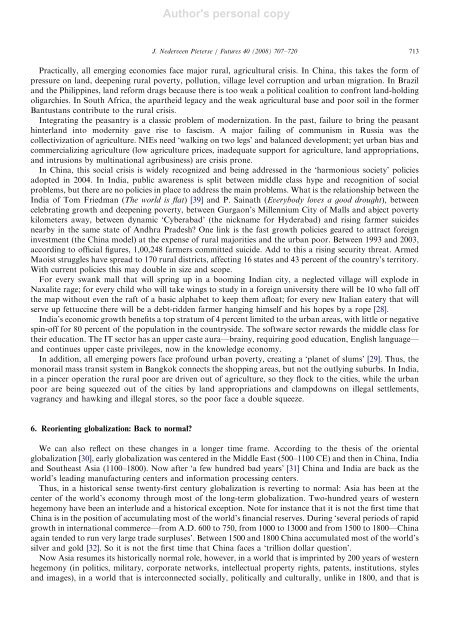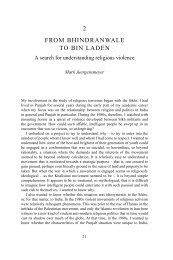New Glob Fu JFTR1275.pdf - Jan Nederveen Pieterse
New Glob Fu JFTR1275.pdf - Jan Nederveen Pieterse
New Glob Fu JFTR1275.pdf - Jan Nederveen Pieterse
You also want an ePaper? Increase the reach of your titles
YUMPU automatically turns print PDFs into web optimized ePapers that Google loves.
Author's personal copy<br />
ARTICLE IN PRESS<br />
J. <strong>Nederveen</strong> <strong>Pieterse</strong> / <strong>Fu</strong>tures 40 (2008) 707–720 713<br />
Practically, all emerging economies face major rural, agricultural crisis. In China, this takes the form of<br />
pressure on land, deepening rural poverty, pollution, village level corruption and urban migration. In Brazil<br />
and the Philippines, land reform drags because there is too weak a political coalition to confront land-holding<br />
oligarchies. In South Africa, the apartheid legacy and the weak agricultural base and poor soil in the former<br />
Bantustans contribute to the rural crisis.<br />
Integrating the peasantry is a classic problem of modernization. In the past, failure to bring the peasant<br />
hinterland into modernity gave rise to fascism. A major failing of communism in Russia was the<br />
collectivization of agriculture. NIEs need ‘walking on two legs’ and balanced development; yet urban bias and<br />
commercializing agriculture (low agriculture prices, inadequate support for agriculture, land appropriations,<br />
and intrusions by multinational agribusiness) are crisis prone.<br />
In China, this social crisis is widely recognized and being addressed in the ‘harmonious society’ policies<br />
adopted in 2004. In India, public awareness is split between middle class hype and recognition of social<br />
problems, but there are no policies in place to address the main problems. What is the relationship between the<br />
India of Tom Friedman (The world is flat) [39] and P. Sainath (Everybody loves a good drought), between<br />
celebrating growth and deepening poverty, between Gurgaon’s Millennium City of Malls and abject poverty<br />
kilometers away, between dynamic ‘Cyberabad’ (the nickname for Hyderabad) and rising farmer suicides<br />
nearby in the same state of Andhra Pradesh? One link is the fast growth policies geared to attract foreign<br />
investment (the China model) at the expense of rural majorities and the urban poor. Between 1993 and 2003,<br />
according to official figures, 1,00,248 farmers committed suicide. Add to this a rising security threat. Armed<br />
Maoist struggles have spread to 170 rural districts, affecting 16 states and 43 percent of the country’s territory.<br />
With current policies this may double in size and scope.<br />
For every swank mall that will spring up in a booming Indian city, a neglected village will explode in<br />
Naxalite rage; for every child who will take wings to study in a foreign university there will be 10 who fall off<br />
the map without even the raft of a basic alphabet to keep them afloat; for every new Italian eatery that will<br />
serve up fettuccine there will be a debt-ridden farmer hanging himself and his hopes by a rope [28].<br />
India’s economic growth benefits a top stratum of 4 percent limited to the urban areas, with little or negative<br />
spin-off for 80 percent of the population in the countryside. The software sector rewards the middle class for<br />
their education. The IT sector has an upper caste aura—brainy, requiring good education, English language—<br />
and continues upper caste privileges, now in the knowledge economy.<br />
In addition, all emerging powers face profound urban poverty, creating a ‘planet of slums’ [29]. Thus, the<br />
monorail mass transit system in Bangkok connects the shopping areas, but not the outlying suburbs. In India,<br />
in a pincer operation the rural poor are driven out of agriculture, so they flock to the cities, while the urban<br />
poor are being squeezed out of the cities by land appropriations and clampdowns on illegal settlements,<br />
vagrancy and hawking and illegal stores, so the poor face a double squeeze.<br />
6. Reorienting globalization: Back to normal?<br />
We can also reflect on these changes in a longer time frame. According to the thesis of the oriental<br />
globalization [30], early globalization was centered in the Middle East (500–1100 CE) and then in China, India<br />
and Southeast Asia (1100–1800). Now after ‘a few hundred bad years’ [31] China and India are back as the<br />
world’s leading manufacturing centers and information processing centers.<br />
Thus, in a historical sense twenty-first century globalization is reverting to normal: Asia has been at the<br />
center of the world’s economy through most of the long-term globalization. Two-hundred years of western<br />
hegemony have been an interlude and a historical exception. Note for instance that it is not the first time that<br />
China is in the position of accumulating most of the world’s financial reserves. During ‘several periods of rapid<br />
growth in international commerce—from A.D. 600 to 750, from 1000 to 13000 and from 1500 to 1800—China<br />
again tended to run very large trade surpluses’. Between 1500 and 1800 China accumulated most of the world’s<br />
silver and gold [32]. So it is not the first time that China faces a ‘trillion dollar question’.<br />
Now Asia resumes its historically normal role, however, in a world that is imprinted by 200 years of western<br />
hegemony (in politics, military, corporate networks, intellectual property rights, patents, institutions, styles<br />
and images), in a world that is interconnected socially, politically and culturally, unlike in 1800, and that is





